Top Things to Do on Easter Island & All You Need to Visit
Looking for the top things to do on Easter Island? Don’t miss a single thing on this once-in-a-lifetime experience!
There are some images that you know instantly when you see them, and the incredible moai statues from Easter Island are a perfect example. One look and you know exactly what and where it is. I have always been fascinated by these statues, and visiting Easter Island has been on my bucket list for years.
The story of the people of Easter Island is fascinating — a complex ancient civilization on a small and remote island in the Pacific Ocean. A people mostly unimpacted by outsiders with a civilization that peaked, then nearly went extinct.
What is the true story of the Rapa Nui, the tribe that currently lives on the famous Easter Island? I had the amazing opportunity to learn all about it when I visited, and I’m thrilled to share it with you.
This guide includes practical information for visiting Easter Island, as well as the history and culture woven through the tours I took. I think it’s so important to know both to appreciate what you’ll see on this incredible island.
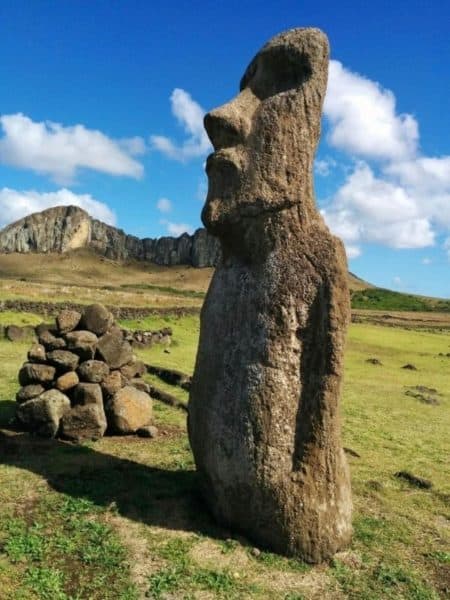
Some links in this article may be affiliate links, which means that if you purchase through them, I receive a small commission. This will never cost you extra. Please read the disclosures to learn more.
Top Things to Do on Easter Island
If you’re looking for a quick list to tempt you to book this trip, I’m happy to comply! Here are the top things to see and do on Easter Island:
- Visit the Easter Island Moai—You can do this at a number of sites around the island, including Tonariki, Aka Hanga, and Te Pito Kura.
- See the quarry, Rano Raraku, where the stone was used for the Moai.
- Enjoy the beaches, including the stunning Anakena Beach.
- Check out the Ahu Tahai ceremonial complex.
- Meander around the harbor town, Hanga Roa.
- Visit Rano Kau Volcano and the Orongo ceremonial village.
- See the Vinapu Village ruins.
- Go diving and swimming in the gorgeous waters surrounding the island.
- Watch the Te Ra’ai Show, a local storytelling show.
Read on for more details about these incredible things to see and do. I’ll weave in the stories shared by our tour guides for each of the sites below.
What Are Easter Island Moai?
During the height of Easter Island, close to a thousand moai were built, and around a quarter of them were placed on platforms called ahu. The ahus are often burial places and religious locations so it’s forbidden to go close to them. The Rapa Nui people believed in life after death, and the moai represented the souls of the people’s dead ancestors.
Many of the moai were placed near where the people lived in settlements. It’s believed that they faced inward to the settlements and served to protect the Rapa Nui people. Several waves of people came to conquer the island, including the Dutch and the British.
Sadly, all of the moai were toppled, though some have been recreated so people can see what they looked like. The moai were built with pukao, also called topknots, placed on the top of the heads.
They are sometimes mistakenly believed to be a hat. However, they were to represent red hair as the locals died their hair red.
Easter Island Moai and Sites to Visit
I toured several incredible sites and spent a day walking among the moai. I still get goosebumps thinking about it. Following are the sites from our tour, and though I don’t see our tour listed any longer, I have shared a number of great options above.
Tonariki
Tonariki features a row of 15 moai that once stood watching over families that lived in the area. The ahu that the moai rested on isn’t far from the ocean. It’s a beautiful and relaxing area to walk around.
The area was reconstructed by a Japanese company as the ahu was destroyed in 1960 by a tsunami that washed the stones over 200 meters inland. The company paid over $2.5 million for the restoration and supplied the cranes for the work.
Thirty-three statues and ahus were found in this area. There is a terrace under the ahus for decoration, and they always have them. The water is glorious shades of teal and navy, and we were there for around an hour to view the area.
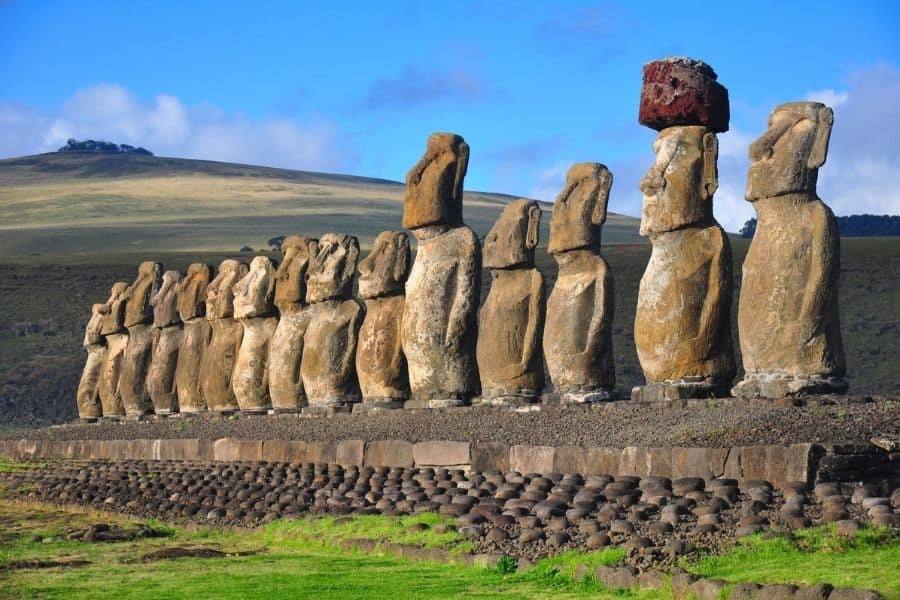
Aka Hanga
Aka Hanga is in ruins. However, it’s considered one of the most important areas on the island. The remains of an old village remain, and you can see the foundations of several structures.
Near the houses are several old stone ovens. There is also a small cave where people once went to seek shelter from the rains.
There is a large ahu platform with toppled statues not far from the remains of the homes. Many of the moai fell face up, and you can make out the features easily despite the erosion.
According to oral tradition, the first king of the island was buried here, though evidence has not been found.
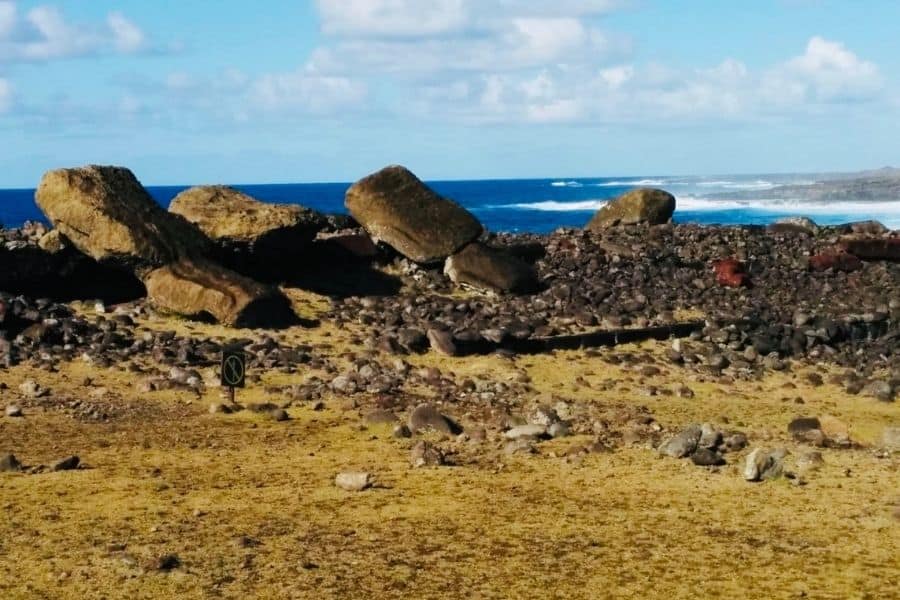
Rano Raraku
This was one of the most interesting of the sites, in my opinion. The stone used to carve the moai statues came from a quarry on one side of the island called Rano Raraku.
It is on the side of a large caldera formed after a volcanic eruption emptied out a magma chamber. When large volumes of magma, or molten lava, erupt over a short time, the support for the rock over the magma chamber is lost and caves in.
Rano Raraku is on the side of the caldera. It took one-to-two years to carve each of the moai. If you think about the number of moai around the island and their limited tools, this is quite impressive.
Walking around the area, you can see hundreds of statues in various states of progress still where they stopped working on them. Inside the crater, there are around another 100.
Though we recognize the moai heads, the statues are actually a head and a body. The bodies are often below the ground due to the elements and time. In Rano Raraku, there is one complete moai statue that shows the full body.
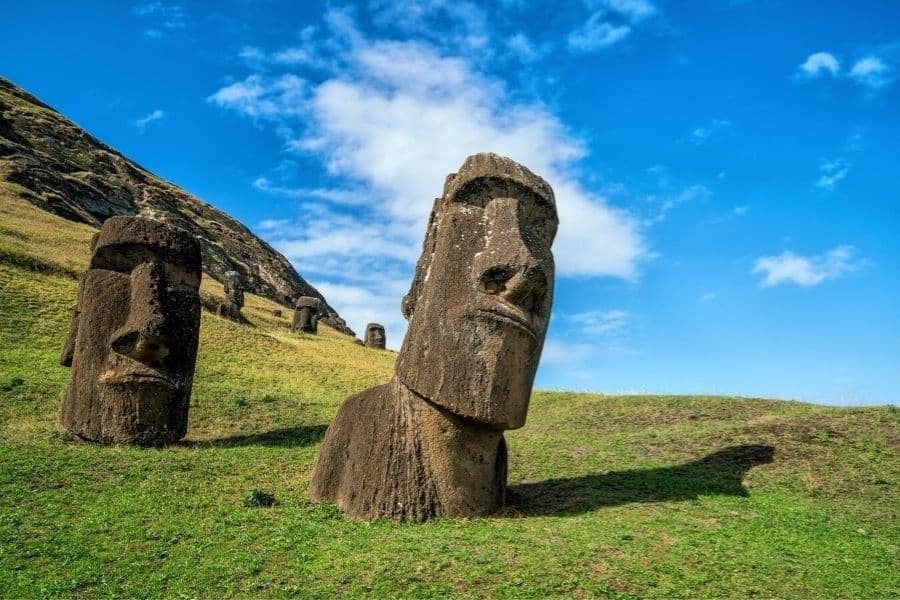
Te Pito Kura
Another site is Te Pito Kura. It was a small site with one fallen statue. It’s believed to have been the last one toppled and one of the largest. This is the site where, in 1786, the French disembarked for the first time on the island. This site also has a lot of ruined homes.
Anakena Beach
There are two sandy beaches on Isla de Pascua, and this one is simply stunning! It’s such a beautiful place, especially due to the contrast between the beautiful white sand, the large black pitted lava rocks sprinkled around the beach, and the teal and turquoise waters.
There is a large hill covered in a carpet of bright green grass. A ways behind it are two ahus. One is very small, and the larger one was recreated with 15 moai. Many of these moai are fairly complete and include the pukao (top knot).
The water was quite cold when we went in September, but the beach is worth taking some time to walk around. There are a bunch of cute little restaurant huts where you can get food and drinks.
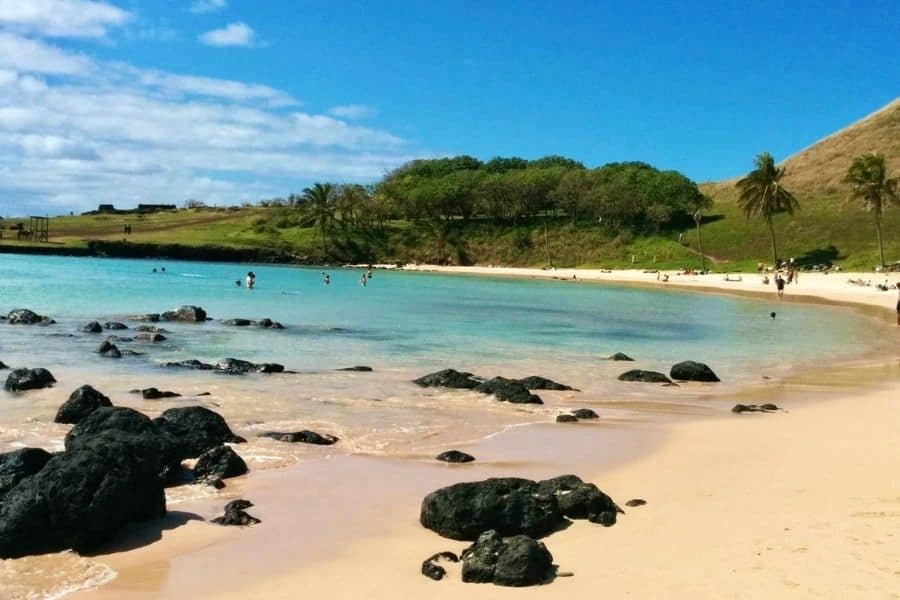
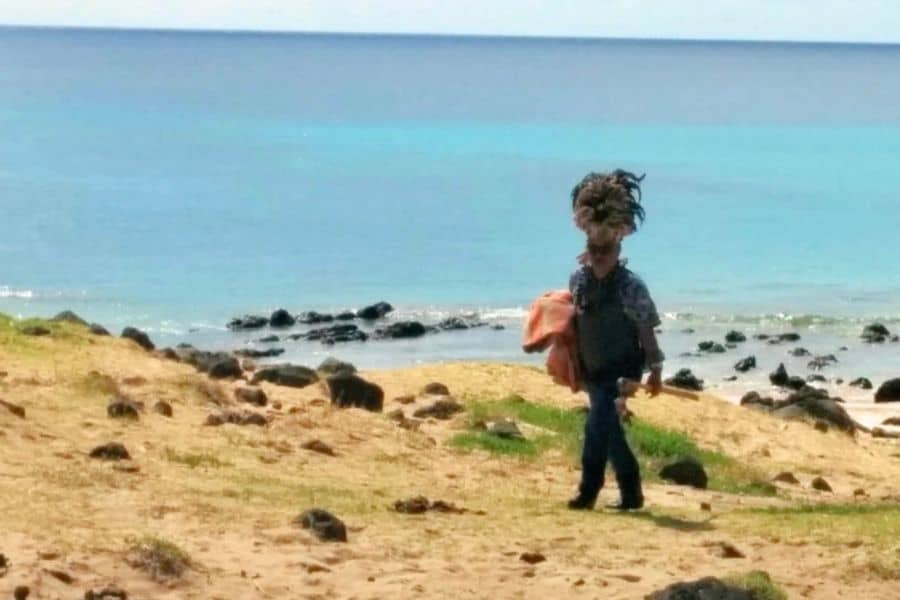
Ahu Tahai
Ahu Tahai is a ceremonial complex right near the town harbor in Hanga Roa. There are some stones with petroglyphs or carvings.
These aren’t just etchings like I have seen in Arizona and Utah, but they are fully three-dimensional. Many represented faces or different shapes that were quite beautiful, all overlooking lava rock cliffs.
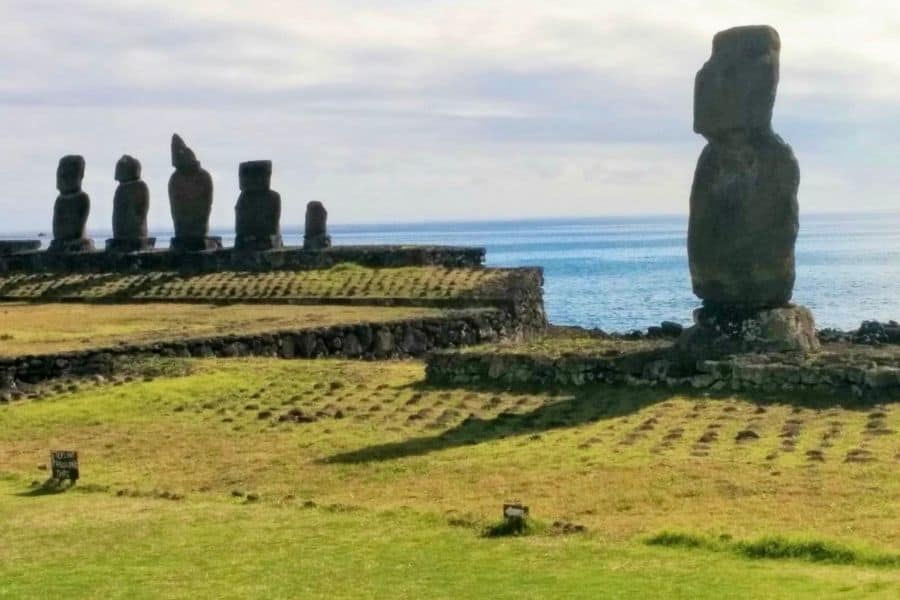
Then, there is a large complex with three ahu. Ko Te Riku is off to one side and has restored eyes. I have to admit it was pretty creepy looking! Tahai is a large ahu with seven restored statues, and Vai Ure is a smaller one nearby.
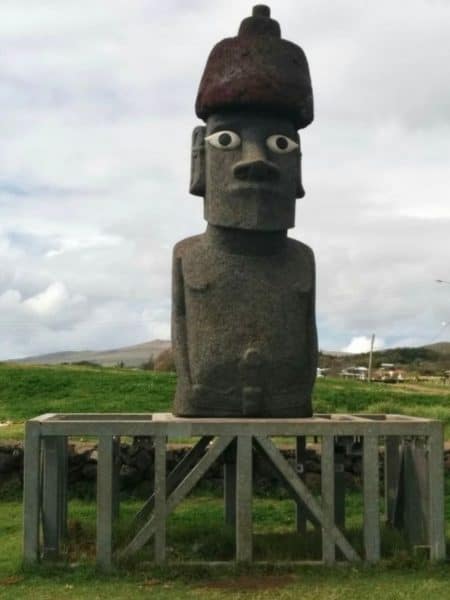
Not far away is a cluster of recreated “chicken houses” and what looks like a very old boat ramp.
Rano Kau Volcano
We visited the sacred Rano Kau volcano, the largest one on the island. The crater is almost 1 mile in diameter. This volcano was the second to erupt on this island around 2.5 million years ago.
The last eruption was around 180,000 years ago. A caldera remains from the volcano, and the lake made from rainwater is around 650 feet down (200 meters).
From a distance, you can see a lot of reeds down in the caldera. There are also avocados, figs, and grapes introduced as the microclimate within the caldera is the right temperature and humidity to support these crops.
There are beautiful views of Hanga Roa from the top of the volcano as well. You can see the airport, which was created as an emergency plan for the space shuttle and is now used by the locals to get to the mainland.
We were also able to see a large cargo ship that arrived in the harbor from Valparaiso, Chile. It takes around 8 to 10 days to arrive and is the primary means for items that are not grown on the island. You can also see a new hospital in the distance, though only general medicine is provided on the island.
The ground glitters with obsidian, a shiny black volcanic glass. It was often used to make the pupils in the moai statues and to make arrowheads as well.
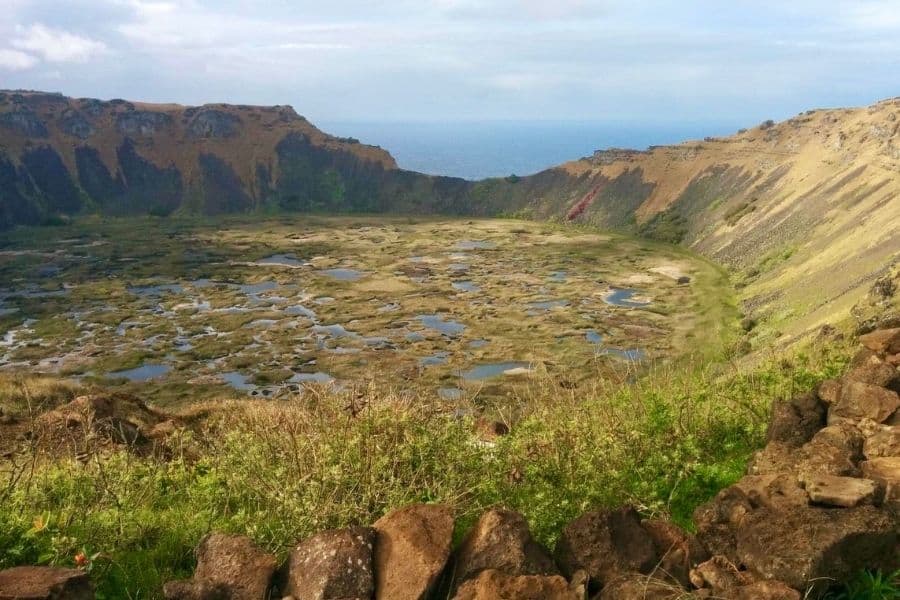
Orongo
One of the most fascinating parts of the island for this history nerd was about Orongo and the Birdman. The Rapa Nui had a democratic process of sorts for selecting their leadership on an annual basis.
This was started in the later years of the height of the island, though it’s not known exactly when. This story is all about the rise and fall of Easter Island.
Near the top of Rano Kau is Orongo, a ceremonial village that was built on the site in the 15th and 16th centuries. It was built to be a political and religious center, and it was not used for living. Orongo was believed to have been built in the 15th and 16th centuries.
This is where the ancient and very important tradition of the Birdman was conducted from the height of the Rapa Nui people. Every year in September, for a few weeks, the chiefs, priests, and warriors from around the island would go for the Birdman ceremony.
Though the site was destroyed, it has been partially recreated in the 1970s. You can see some of the structures in this area as they were during the height of power. There is a very modern ranger’s station and a trail through this area leading to one side.
From the trail, where you can see three islands off the shore of the volcano. Moto Nui is a big island, Moto is small, and Moto Kau is the tall and pointy one. They play an important role in the Birdman ceremony.
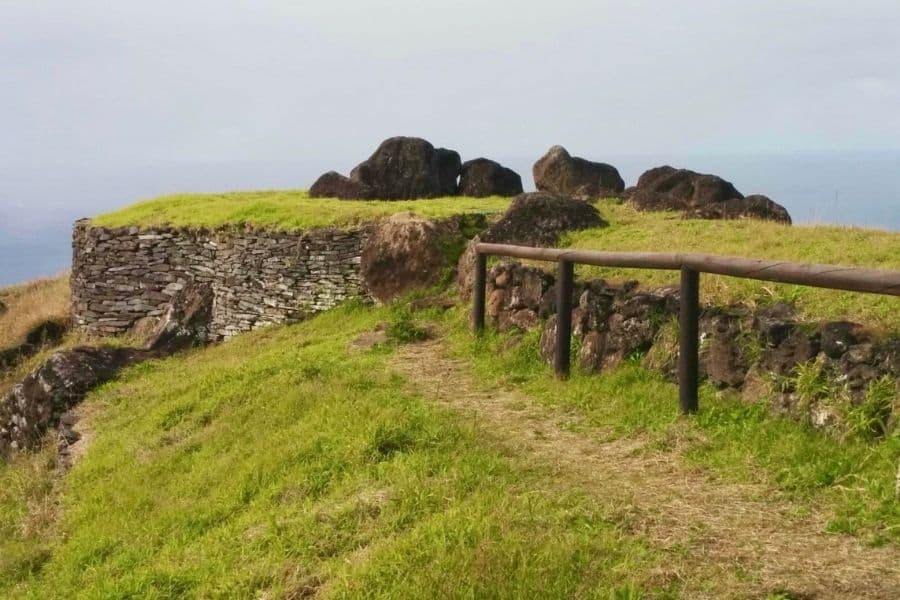
The Birdman Ceremony
During the height of Easter Island, it was a democracy of sorts based around an annual competition. Every year, the chiefs that ruled the tribes on the island chose their best warriors to compete in a contest to determine the ruler of the island for the next year.
This religious ceremony was in honor of Maki, considered the most important god to the Rapa Nui. This competition was political as well as religious, as the winning tribe gained control of Rapa Nui.
There are petroglyphs in this area that recount the story of the Birdman.
The Competition for Rule
The warriors climbed down the Kari Kari depression into the volcano, cut some of the reeds to construct a float, and then swam to the largest island off the coast called Moto Nui.
There, they would wait for the migratory birds to arrive, called the sooty term. The first to find an egg from the bird would then call out to the chief. Orongo means “to hear” in the native language. Then, the chief prepared for the ceremony by sharing his head for purity.
Meanwhile, the warrior put the egg in a basket tied to his head and swam back. He climbed the cliff to return to the top of the volcano and presented the egg to the priest, who then presented it to the chief at sunset. The winning chief then became the Birdman, ruler of the entire island for one year.
Following the ceremony, the Birdman was taken by a caravan, singing and dancing back to a holy place. If the tribe lived in the eastern areas of the island near the volcano, they stayed nearby.
If they were from the west of the island, they went to Anakena Beach. The priest and chief were then in seclusion for one year, with the priest caring for the Birdman, now considered a sacred person.
The Birdman tribes ruled from the end of the Moai period, around the 1600s, to 1864, when French Catholic missionaries arrived and converted most of the island to Christianity.
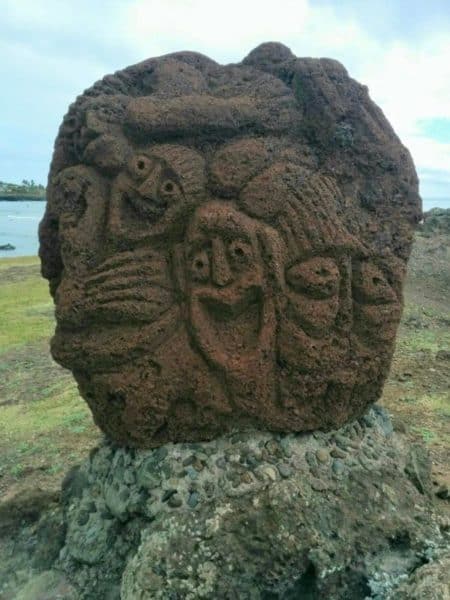
Vinapu Village Near Rano Kao
This is a village located close to the volcano. There is a path down the side of the caldera that was the water source for the village.
We met a woman who lived there when she was young. She said that she remembered her mother going to the caldera to do her washing as there wasn’t enough water in the village for it. That was around 50 years ago.
The fern roots that grow in the caldera are used for medicine (matua pua), and they are believed to treat diabetes and cancer.
There were two nearby villages with moai sites nearby, all in ruins. You could see the foundations of ancient homes and cooking pits. Interestingly, there is an ahu near the water with a wall of rock built similar to the Inca style, where large rocks were carefully fitted together without mortar. It was the last built on the island and was one of the largest.
An anthropologist used this to support his theory that the Rapa Nui came from mainland South America. However, when he tried to test his theory by building a wooden platform boat as would have been used back then, he was unable to get to Easter Island due to the currents.
Other Things to Do on Rapa Nui
Though island tours are some of the most popular things to do when you visit Easter Island, there are some other fun things to consider. If you have a few days, here are some additional things to check out.
Explore the Harbor at Hanga Roa
The harbor is a great place to meander after a busy day checking out the moai.
The harbor is lovely, and there are some great restaurants overlooking it. You’ll also find many small boutique shops for souvenirs, snacks, etc.
It’s a great place to see some of the locals and people-watch, as well as check out the tourists that are visiting. Grab a drink and watch the sunset!
Dive and Snorkel
There is a lot of amazing marine life, and it’s a hot place to go diving or snorkeling. Another option is to go on a boat ride to check out the area. A glass-bottom boat is a great option to see above and below the water. There are also some moai below the water that you can see.
Te Ra’ai Show
When you go to Hawaii, you see a luau. It’s a bit campy but lots of fun. When you visit Easter Island, I also recommend going to a similar show. Te Ra’ia is a fun place to go, though there are others.
The owners take great pride in showing off their Rapa Nui culture. For 40,000 Chilean Pesos per person (around $50 USD), they handle transportation to and from the restaurant. You go to see a traditional dance show that lasts around an hour. Additionally, you get Rapa Nui dance lessons and a tasty food buffet with wine. They also will paint your face with a light tan-colored paint in interesting stripes and designs.
There is a small band of 6 that plays some interesting instruments. The master of ceremonies speaks in both English and Spanish. The women wore mostly bikinis of shells and feathers, and the men were similarly attired.
The dance is a history of Easter Island, and it’s quite stunning. There is chanting and war dancing, and it is beautifully choreographed. We had a good laugh as there was apparently one new guy who kept messing up his steps, though everyone else was quite impressive. One woman did a lot of belly dancing, and it was quite amazing.
The Te Ra’ai show is offered only a few days a week, on Monday, Wednesday, and Friday. Reservations are required as there is limited seating for only around 50 people.
The show ends at around 11, and it is quite dark on the island as there are not a lot of lights. So, it’s a good idea to take their transportation unless you have a car.
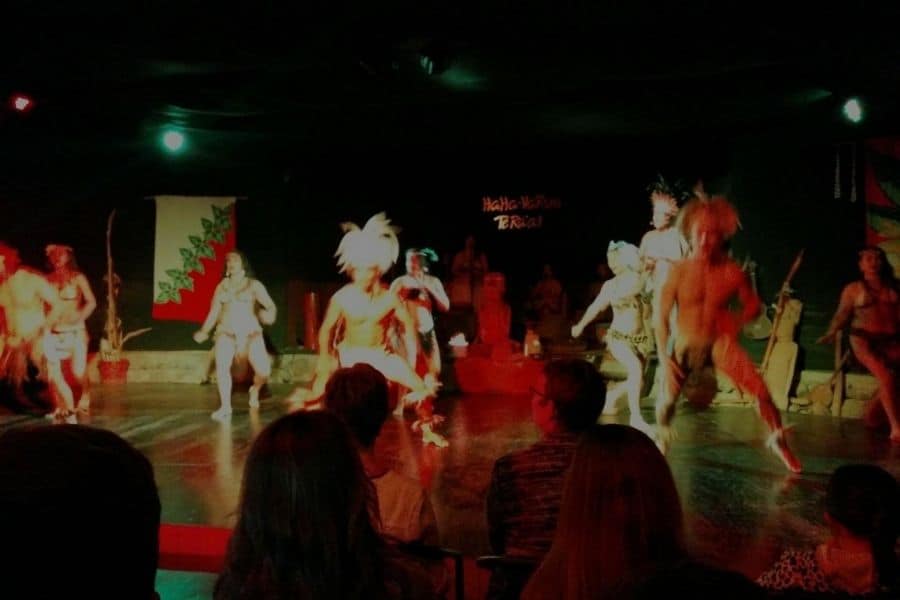
How to Visit Easter Island
When I visited Chile, my only must-see was a trip to visit Easter Island. It’s actually almost 3,700 miles off the coast of Chile. So, while Santiago, Chile, is the closest large city to it, it’s quite a distance.
It was annexed by Chile in 1888, though the people were mostly unintegrated given the remoteness of the island. The flight takes over five hours, and it’s costly as only one airline covers this route. Fares tend to be around $750 – $800 USD, though you can occasionally get flights for around $550 USD. But it is every bit as amazing as you might imagine and worth going.
There is one flight a day from Santiago, Chile, to Easter Island on Latam Airlines (formerly LAN). This is the only direct flight from the mainland, so if you want to fly from another city, you will have to connect through Santiago.
You may find tours to Easter Island from Santiago. Honestly, you’re better off scheduling your own flight and meeting up with a tour when you arrive. There are a lot of tours to Easter Island!
Visiting Easter Island is a once-in-a-lifetime experience not to be missed!

Easter Island Airport
The airport on Easter Island is as tiny as you might imagine. It looks similar to some of the Caribbean airports. “Terminal” may be a bit strong of a term to describe it. You walk down onto the tarmac to get your bags. Then, head to a small building with an open seating area, a couple of small stores, and shops. There is not much else there to see.
The runway is surprisingly short, and I was glad I saw that after I landed. 🙂 Since there is only one flight a day, it’s a bit of a madhouse to get out of the building and find your driver. You have the option to rent a car, though they are quite expensive here. And depending on what you do, you may not need one.
We were greeted at the tiny Easter Island airport with beautiful fresh flower leis and our driver escorted us to our car. There were maybe 20 in the parking lot, so it wasn’t hard to find.
It took less than two minutes to drive to our apartment, which would be our home for the next few nights. It was funny in hindsight that we got a driver to pick us up when we could have walked in ten minutes, though these are the things you learn when you travel!
Where to Stay on Easter Island
We were warmly greeted at our accommodation, something we would get used to while on the island. When you visit Easter Island, you will find everyone is very warm, friendly, and welcoming to tourists. Of course, tourism is the largest industry on the island.
I chose Marae Cabanas, and we were thrilled with this place. Though the description showed it as a one-bedroom, we got a place with two bedrooms and bathrooms. It was spacious, well-appointed, and comfortable, and it had a full kitchen as well.
It’s in an ideal location, only a ten-minute walk from Hanga Roa Harbor, where there are a number of shops, stores, and restaurants.
It’s a little set back as well, so it was nice and quiet, well, except for the farm animals all around. There were a number of very chatty roosters, sheep, and horses all nearby, so if you’re a light sleeper, be warned!
We were told to make sure we closed the gate to the property at night, or a horse might wander onto it. After coming right from Santiago to visit Easter Island, it could not have been more different!
The staff was all wonderful and very helpful with recommendations and reservations. There was lovely fresh papaya for us when we arrived. There are six independent buildings on the property with some nice amenities including laundry facilities, a barbeque grill, as well as a drying rack for clothes and beach chairs to borrow.
Marae Cabanas is located at Calle Tu’u Koihu s/n, 2770000 Hanga Roa, Chile.
Other Easter Island Accommodation
If you’re looking for something a bit more upscale, here are a couple of options in the Hanga Roa area:
- Hotel Hangaroa Eco Village & Spa—This luxurious resort is a top pick for Easter Island. It has a spa, outdoor swimming pool, stylish rooms, and a restaurant overlooking the water.
- Hare Nua Hotel Boutique—I love boutique hotels, and this one looks wonderful! There is a hot tub, on-site bar, and city or garden views, and your stay includes an organic breakfast.
What It’s Like to Visit Easter Island
The people of Easter Island are all very welcoming and friendly. They are helpful to foreigners and understand that tourism is their lifeblood.
I did have a funny experience on my first night walking around the town of Hanga Roa. A woman was staggering down the street, and when she approached us, she was clearly quite drunk. She held her hand out and said something, apparently asking for money. We shook our heads and kept walking.
She stopped and said something very rapidly, then proceeded to smack me on the butt! I can honestly say that was a first for me, and I had no idea how to react. I burst out laughing. She laughed as well, so maybe that was the reaction she was aiming for.
Easter Island is a beautiful and fairly simple place. We stayed mostly in the Hanga Roa area except when we toured the island to see the moai. The buildings and homes are well-kept and modest.
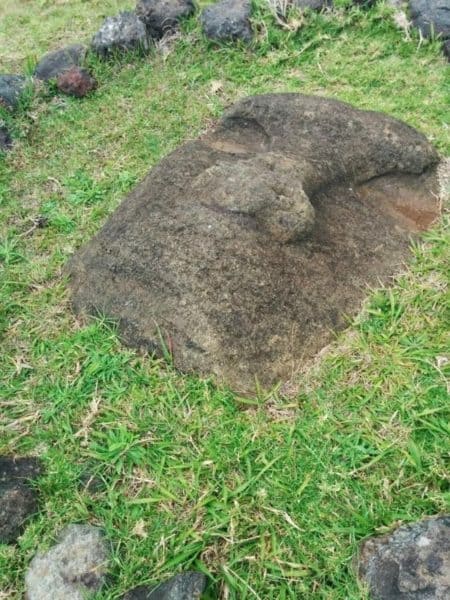
Animals on the Island
There are a lot of loose dogs and loose animals, for that matter. We saw lots of chickens, dogs, cats, roosters, as well as goats around.
The condition of the animals is not great, so it’s a bit heartbreaking for an animal lover like me. Unfortunately, vet care available is minimal and costly, so they are left to fend for themselves mostly.
Getting Around When You Visit Easter Island
Since rental cars are expensive on the island and I love learning the history of places I visit, I decided to join a small group tour. This way, I knew I’d learn all about the moai, the people, and the island’s history from a native.
I don’t see the company listed that we used, and here are some great options for small group tours that touch on the history and culture of the Rapa Nui people.
The historical information I share in this piece is what I documented from the tour that I took. Interestingly, what I have found in doing some research for this piece is that there is a lot of conflicting information about the island and the people.
This includes when the Polynesians arrived, what Easter Island was like when the Dutch arrived, and some other areas as well. Since my tour was given by a native Rapa Nui, I have included his accounting of the history.
Best Time to Visit Easter Island
Easter Island is in a subtropical area with warm temperatures and high humidity year-round. There is often a light breeze, so it’s reasonably pleasant, no matter when you go. The island is located in the Southern Hemisphere, so seasons are reversed compared to the United States and Europe.
The summer months of December through February are the best time to go to Easter Island. The warmer weather is appealing, as is the increase in flights during this time. However, it’s also when more tourists go. Border season is October and November, and March and April, offering good weather and fewer tourists.
The highest temperatures are from January to March, and though they rarely hit over 81°F (27°C), they can go as high as 95°F (35°C). In the winter on the island, temperatures sometimes go as low as 50°F (10°C). The average is around 74-75°F (23-24°C).
Rainfall is prevalent throughout the year, and the island gets around 42 inches (over 1,000 millimeters) a year. The highest rainfall is in April and May, occasionally from June to August.
Easter Island Restaurants
There are a number of really good restaurants that you will want to try when you visit Easter Island. Many of the restaurants here offer great locally-caught fish and I highly recommend it if you do like fish.
- Haka Konu — This was one of our favorites, and we actually went through it twice. It overlooks the Hanga Roa Bay and two moai. I got my first Easter Island fish here, a white fish called wahu that had the consistency of swordfish cooked with papaya and tarro.
- Kuki Varua — Another great place for fish and try the kana kana if they have it.
- La Kalenta — This place is wonderful. It is right on the water with beautiful views of the waves crashing up on the lava rocks along with a tiny sandy beach. If you have good weather, you can watch the sunset over the water.
- Te Moana — Te Moana is right next to La Kalenta, and it was also really good and worth visiting. It has ocean views as well and really great food and service.
- Izakaya Kotaro — If you like sushi, this is the place to go. Do yourself a favor and make a reservation. Even on this small island, this place gets packed as the word is out! The chef, Franciso, is Japanese-trained and imports most of his ingredients from Japan. It is quite expensive, especially by Easter Island standards, but worth every penny.
There are a number of small shops where you can find groceries if you rent an apartment. Prices are high on the island as everything must be imported.

How to Get to Easter Island
When you visit Easter Island, you really only have one option to get there—by plane. There’s only one airline that flies to Easter Island, Latam.
There are only one or two flights daily, depending on the time of year. Flights depart from Santiago, and it takes around six hours to get there. It generally takes less time to return due to winds.
Be prepared as flights are quite expensive, given the limited competition. When I went, flights cost around $700, though you can sometimes get flights for a lit
Looking for More? A Quick History of Easter Island
The people who live on Easter Island, called Rapa Nui, originally came from Polynesia between 400 and 800 AD. There were two waves of immigration. The first wave was called the “long ears” as they extended their ear lobes for the look of it.
The second was called “short ears,” as they had normal-length ears. The long ears were the ruling class, and the short ears were the working class.
In around 800 AD, the Ancestor’s Cult, also called the Moai Cult, won power and took control of the island. They ruled it from around 800 AD to around 1600 AD, when the Rapa Nui people almost became extinct.
The Near Extinction of Rapa Nui
At the height of this civilization in the 1600s, the population rose to around 20,000 people. This growth led to the downfall of this civilization, in part because of the size of the island. It is very small and only 15 miles by 10 miles (24 km by 16 km).
150 square miles is not a lot of space for such a large population, and it simply didn’t have the resources to sustain them. By comparison, there are currently believed to be just under 8,000 people living on the island today.
The population plummeted due to a number of factors. They included war, limited resources, overpopulation, and starvation. Isla de Pascua, Easter Island, may serve as a cautionary tale.
Its history highlights the issues caused by not respecting natural resources. As well as the impact of uncontrolled growth, particularly in an area with space limitations. It seems like so much to have been through for this quaint and sleepy small island.
The island was covered in trees but was slowly deforested. One of the trees indigenous to the island, a type of palm, is now extinct. It was believed they were cut down to transport the moai. The royal family ruled until 1600, when the war started, and most were killed.
When a census was done in 1877, there were only 111 people left. Many were taken from the island for the slave trade, and many died or were killed.
UNESCO World Heritage Site
Rapa Nui National Park is a UNESCO World Heritage Site and an island located in the southeastern Pacific Ocean. This park makes up almost half of the island. Easter Island is also known as Rapa Nui by the Polynesians who populated the island. It’s also known as Isla de Pascua, which is its Spanish name.
It was recognized by UNESCO for bearing witness to a unique cultural phenomenon expressed by the Moai sculptures. Easter Island is the most remote inhabited island on the planet. It was free from any external influence until around 1722, when the Dutch first invaded. The enormous stone moai continues to fascinate people all over the world, and they are a huge draw to visit.
As you will know if you have read other posts on this blog, I love UNESCO sites and seek them out. They are always interesting and offer unique perspectives to their respective areas. There are over 1,100 sites in the world, and when you find them, they are almost always worth visiting.
It had been a dream of mine to visit Easter Island, and it was quite special. It’s a true bucket-list adventure. If you’re interested in history and culture as well as beautiful scenery, this is your kind of place.
Why You Should Visit Easter Island
I loved everything about Easter Island. There is a wonderful and soothing relaxed island energy and beautiful beaches. Of course, a top draw to this remote island is the incredible history and the picturesque moai statues scattered around the island. This was truly a bucket list dream come true.
It’s an incredible adventure to walk among the moai and, truly, something to add to your bucket list. Though the beaches are truly spectacular, I encourage you to visit Easter Island and learn about its incredible evolution.
You Might Also Like
- Places to Visit in Chile: The Trip I Never Want to Repeat
- 17 Cool Things to do in Santiago: Chile’s Fun Capital
- 11 Top Things to Do in Valparaíso, Chile—the Colorful Culture Capital
- The Best Santiago Wine Tours—Concha y Toro Winery and Santa Rita




I enjoyed reading this article. My husband and I are booked to go to Easter Island November 2022. We are traveling with a Viking Expedition group. I have wanted to visit since I was a little girl and saw/read a story about the island and the mystery of “what happened”. I am saving this into my travel file.
It’s an incredible place with an absolutely fascinating history! I definitely recommend traveling some with a guide to learn the stories.
Hoe many day trip would you recommend for Easter Island?
I’d recommend between three and five days, depending what you want to do when you’re there.